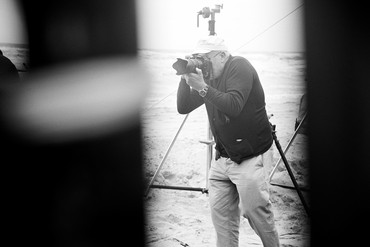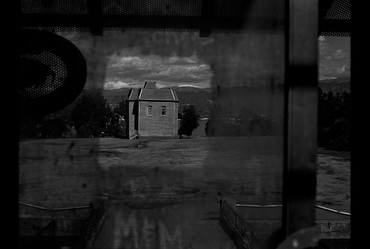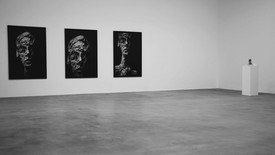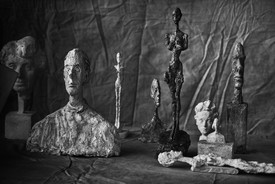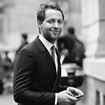
Derek Blasberg is a writer, fashion editor, and New York Times best-selling author. He has been with Gagosian since 2014, and is currently the executive editor of Gagosian Quarterly.
Derek BlasbergHi, Benjamin! I’m happy to talk to you about your father’s incredible body of work. How involved have you been with his estate since he passed away in 2019?
Benjamin LindberghMy three brothers and I, as per Peter’s wish, are now all part of his foundation’s board. From its inception, which our father supervised, the foundation’s aim has been to carry on his particular stance on fashion photography, as testified to by an extensive oeuvre spanning over four decades. Following his passing, the Peter Lindbergh Foundation has remained focused on documenting, preserving, and presenting his singular work and his enduring viewpoint on beauty. Since its initial opening at the Kunstpalast Düsseldorf in February 2020, Untold Stories has traveled to Hamburg and Darmstadt in Germany, and Naples and Turin in Italy. We’re thrilled to present the exhibition now in A Coruña.
DBDid your father call himself a photographer or an artist?
BLPeter unapologetically defined himself as a fashion photographer and never felt any complex about not being “branded” an artist. Indeed, he often stated that art had historically been commissioned and that’s also why he made no distinction between his commercial and his personal work. Peter’s persona was in no way compromising. I believe he approached his field of work as a craft rather than as art, by staying true to his aesthetics and process, as well as by being loyal to his team, talents, and collaborators of many years. That being said, my father was very adamant that fashion photography can and should exist very well without putting fashion in the center. He wanted his images to transcend their own context and redefine the parameters of photography and contemporary culture overall.
DBTalk to me about this specific show. A port city in Galicia with sweeping coastal views, A Coruña seems like an intentional location for the exhibition. How did you land here, and what did this place mean to him?
BLI totally agree, as I was immediately amazed by the many similarities A Coruña shares with Duisburg and North Rhine-Westphalia, the parts of Germany where Peter spent his childhood—a region that influenced his notion of beauty profoundly. Marta Ortega inviting the Peter Lindbergh Foundation to exhibit Untold Stories in her hometown seems like a full-circle moment. Peter first visited A Coruña on the occasion of Marta’s wedding in 2018, and the vicinity of the Atlantic coast, coupled with the industrial harbor, strongly resonated with him. I believe he would have felt at home away from home.
DBI was told the process of putting together this exhibition was a long one for your father and that he agonized over it. How did he hope to be understood in these works?
BLPeter worked fervently on Untold Stories for over two years, dedicating every free moment to researching, editing, and assembling hundreds of photographs, including his longtime favorites and others that have never been seen before. It was his first ever self-curated exhibition, and that idea excited him immensely: to finally be able to tell his story and expose his viewpoint by using his own words and principles. It was by definition a very solitary task, yet Peter was passionate about it, since it allowed him to reflect on his life both professionally and personally, as well as to start considering how he hoped to be remembered.
DBMy favorite pictures of your father’s are the ’90s-era supermodel shots. I still love the one of Naomi Campbell, Christy Turlington, Tatjana Patitz, Linda Evangelista, and Cindy Crawford, which Anna Wintour told me she found in a drawer when she was at British Vogue. Are there any defining images that stand out in your memory?
BLI guess I relate to his “non-fashion” imagery better. In fact, a landscape of Berlin taken at night and showing tower cranes standing in front of a full moon is among my all-time favorites. I also find the closeup shots to be particularly powerful and timeless, in the way that they convey raw beauty paired with bare emotions, be it a portrait or a detail of a hand. I always appreciated how his photographs that were not documenting fashion per se were constantly infused in Peter’s editorials and monographs.
Exhibition video
DBHe has left behind a wonderful body of work and has made a lasting impression on the worlds of fashion, photography, and art in general. But is there anything that people overlook or are missing from his work that he wanted to communicate?
BLWorking next to Peter for over a decade, I had the opportunity to witness firsthand how a lot of people connected with him. Many felt like they knew him almost on an intimate level—even if they had just met him once or for a brief moment. Only the sum of all these personal accounts could perhaps help define my father’s layered identity. Peter may have not fully grasped how much he and his work shone on others, especially those unconcerned by the fashion industry. His message surpassed his art.
In the context of Untold Stories, the piece entitled Testament [2013], exhibited for the first time, brings to the fore a rather unusual side of Peter’s work, and of his nature as a person. Besides being distinct in its actual form from other works in the show, it has the ability to question its viewers about topics dear to my father: freedom and empathy. These are core values that drove Peter Lindbergh endlessly—on and off the set.
DBWere there any artists or photographers that stood out as inspirations to your father? I know that his idol was Vincent van Gogh, but were there photographers that your father looked up to as well?
BLPeter seemed to care less about the medium than about the message and the creative purpose itself. He valued the content over the vessel, believing in fact that creativity—a concept closely linked to identity—lies within every single individual. Peter often referred to the following quote by Japanese Zen master Shunryu Suzuki: “To express yourself as you are, without any intentional, fancy way of adjusting yourself, is the most important thing.” Therefore names from various artistic fields come to mind: movie director Wim Wenders, contemporary artist Michael Heizer, writer Peter Handke, and choreographers like Pina Bausch, Blanca Li, and William Forsythe.
DBHave you received some of the shirts that Marta [Ortega] created with the foundation, featuring photographs by your father? I made her send me all of them, and I pick which one to wear based on my mood.
BLI have a complete set of my own! We were honored to inaugurate Marta and Zara’s Tribute collection and support the Franca Sozzani Fund for Preventive Genomics.
DBI’m having an Amber-Valletta-as-an-angel kind of day today. How’s your day going?
BLI am having a quiet, self-reflective moment that could be summed up by the 1995 portrait of Antonio Banderas. You should come see it for yourself in A Coruña!
Artwork © Peter Lindbergh, courtesy Peter Lindbergh Foundation, Paris
Peter Lindbergh: Untold Stories, A Coruña, Spain, December 4, 2021–February 28, 2022

